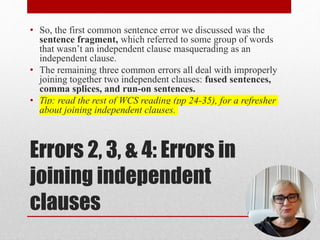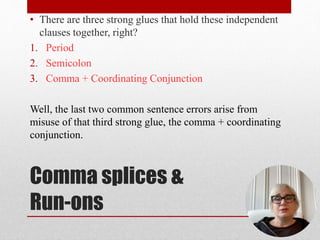Raina Lyons: Four Common Sentence Errors Lecture part 2.pptx
- 1. Errors 2, 3, & 4: Errors in joining independent clauses ŌĆó So, the first common sentence error we discussed was the sentence fragment, which referred to some group of words that wasnŌĆÖt an independent clause masquerading as an independent clause. ŌĆó The remaining three common errors all deal with improperly joining together two independent clauses: fused sentences, comma splices, and run-on sentences. ŌĆó Tip: read the rest of WCS reading (pp 24-35), for a refresher about joining independent clauses.
- 2. How DO you join 2 independent clauses??? ŌĆó There are three correct ways to put two independent clauses together: 1. Keep them as two separate sentences, separated by a period. ŌĆó Ex. The dog ran into the busy traffic. The boy watched with tear- filled eyes. 2. If you want more connection, join them with a semicolon. ŌĆó Ex. The dog ran into the busy traffic; the boy watched with tear- filled eyes. 3. If you want even more connected meaning, join them with a comma + coordinating conjunction ŌĆó Ex. The dog ran into the busy traffic, and the boy watched with tear-filled eyes.
- 3. Joining independent clauses, continuedŌĆ” ŌĆó Think of it as glue: You either leave the two independent clauses stuck together 1) by proximity (and a period), 2) by the strong glue that is the semicolon, or 3) by the two- part epoxy of the comma + coordinating conjunction (FANBOYS) ŌĆó For And Nor But Or Yet So
- 4. Fused sentences ŌĆó Fused sentences happen when two independent clauses are joined up with NO GLUE AT ALL. ŌĆó Ex. The boy ran toward the intersection the car tires screeched.’āĀ See how awkward this is? ThatŌĆÖs why this is a fairly rare error. ŌĆó Fix it: by adding the correct strong glue (period, semicolon, or comma + FANBOYS) 1. The boy ran toward the intersection. The car tires screeched. 2. The boy ran toward the intersection; the car tires screeched. 3. The boy ran toward the intersection, and the car tires screeched.
- 5. Comma splices & Run-ons ŌĆó There are three strong glues that hold these independent clauses together, right? 1. Period 2. Semicolon 3. Comma + Coordinating Conjunction Well, the last two common sentence errors arise from misuse of that third strong glue, the comma + coordinating conjunction.
- 6. Comma splices ŌĆó Comma splices are two independent clauses joined with only a commaŌĆ”BUT A COMMA ISNŌĆÖT STRONG ENOUGH GLUE ALL BY ITSELF! ŌĆó Ex. The dog ran around in circles in the middle of the intersection, the car tires spooked him. ŌĆó Fix it: by a) adding the missing coordinating conjunction: ŌĆó Ex. The dog ran around in circles in the middle of the intersection, but the car tires spooked him. ŌĆó Or by b) changing the comma to a semicolon or a period: ŌĆó Ex. The dog ran around in circles in the middle of the intersection; the car tires spooked him. ŌĆó Ex. The dog ran around in circles in the middle of the intersection. The car tires spooked him.
- 7. Run-on sentences ŌĆó NOTE: Sometimes the term ŌĆ£run-onŌĆØ sentence is lumped together with fused sentence or is simply used to refer to a sentence that is too longŌĆ”thatŌĆÖs NOT how IŌĆÖm using it here. ŌĆó For my purposes, a run-on sentence is the mirror image of the comma splice: ŌĆó A run-on sentence is two independent clauses joined with only a coordinating conjuctionŌĆ”BUT A COORDINATING CONJUCTION ISNŌĆÖT STRONG ENOUGH GLUE ALL BY ITSELF! You need that comma, too. ŌĆó Ex. All the cars had come to a stop and a friendly driver got out of her truck. ŌĆó Fix it: by a) adding the missing comma: ŌĆó Ex. All the cars had come to a stop, and a friendly driver got out of her truck. ŌĆó Or by b) changing the comma to a semicolon or a period: ŌĆó Ex. All the cars had come to a stop; a friendly driver got out of her truck. ŌĆó Ex. All the cars had come to a stop. A friendly driver got out of her truck.
- 8. So thatŌĆÖs itŌĆ” ŌĆó YouŌĆÖve just learned how to correct something like 90% of the errors I encounter when grading! So now, when you see this: ŌĆó The kind motorist holding out her arms. The dog ran to her the motorist smiled and handed the boy the dogŌĆÖs leash. The boy hugged his dog, he turned around and walked toward home. His dog licked the tears from his face and he prayed his parents would never find out what had happened. ŌĆó You can change it to this: ŌĆó The kind motorist held out her arms. The dog ran to her. The motorist smiled and handed the boy the dogŌĆÖs leash. The boy hugged his dog, and he turned around and walked toward home. His dog licked the tears from his face; the boy prayed his parents would never find out what had happened.







